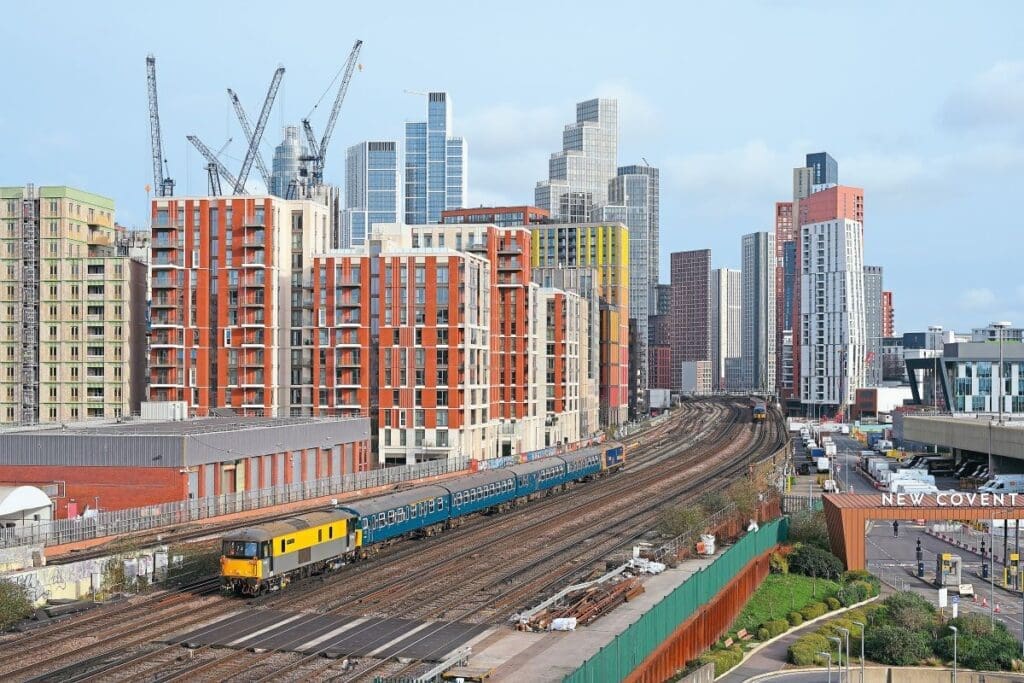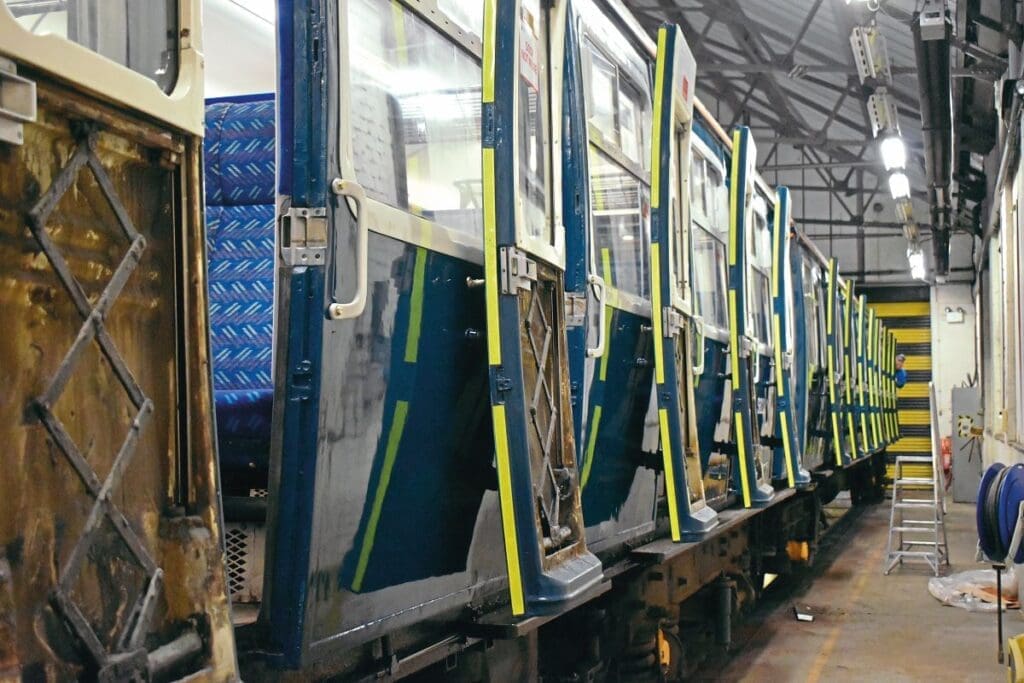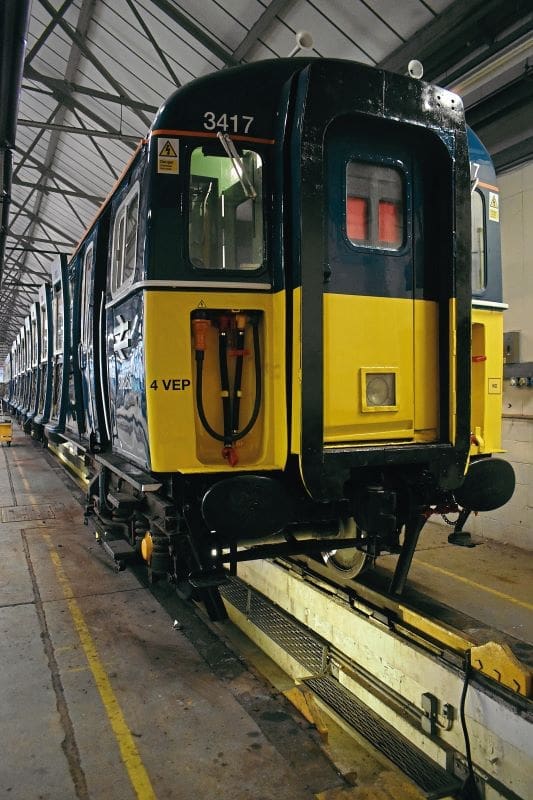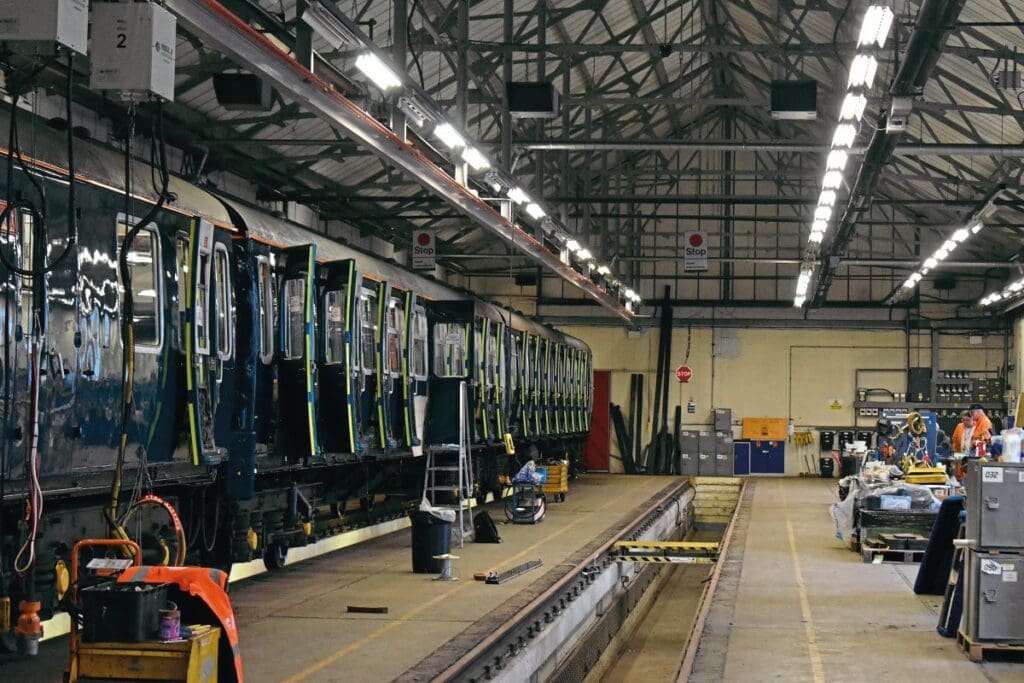Richard Clinnick visits Strawberry Hill, where a small team are returning a Mk.1 slam-door unit to main line condition.

“It’s just like Wimbledon,” says Chris Buckland as he walks around 4-VEP No. 423417 Gordon Pettitt at Strawberry Hill on February 21. “Sometimes I just come in here and listen. The unit is cut in and people are working on it… it’s wonderful.”
The depot is just that, a working depot, complete with live 750v DC third-rail. Next to the main shed, a pair of South Western Railway Class 450s are stabled between peak-time duties.
The site is in the midst of a triangle with various electric multiple units passing all day. Staff for the SWR site come and go.
Inside the shed are a mix of current and former railway people busying themselves on various tasks required to keep the ‘423’ operational. These tasks have been devised by Chriswho wants the depot to operate asif it was still Wimbledon, the depot he only recently retired from having spent 41 years on the railway. There are spares storage areas, workbenches and all sorts of modern equipment required to keep trains operating.
Outside the main shed is an office building where exams are planned, payments are made and tea is consumed. It’s here that Steve Upton comes into his element with his cheerful attitude, incessant jokes and, on the day of RE’s visit, cooking for the troops.
Together with Gwilym Jones, Steve and Chris were the original ‘Three Musketeers’ who, in a pub, decided (most likely after at least five pints each Steve jokes) that saving a Southern Region Mk.1 slam-door EMU and returning it to the main line was a good idea. Sadly ‘Gwil’ passed away in 2019, but his memory and legacy lives on through his friends. “He’d have been so proud,” says Steve.
Electric multiple unit preservation is tough. Projects have been abandoned and vehicles scrapped. In the same week Rail Express visited Strawberry Hill to see the work on the 4-VEP, news broke that the sole-surviving Class 503 would leave Margate with two vehicles set for scrap. They won’t be the first EMU vehicles saved that have subsequently been disposed of and it’s doubtful they will be the last.
“You need a plan. What do you want, how will you do it, how will you fund it and where will you keep it?” says Steve Upton while making RE coffee at the depot. In this corner of London, all of this is in place, and more! There are ideas and there are aspirations. Chris laughs and says that some ideas will only happen “when I’m pushing up daisies”, but he says that not as a defeatist or someone who is against what others, mainly Steve, suggest, rather, he looks at the costs, timescales and changing goalposts as the obstacles to any dreams.
The Southern Electric Traction Group (SETG) are the operators of the only preserved and main line-registered EMU in Britain – No. 423417. It is owned by the Bluebell Railway, but the SETG are its custodians.
Ideally the dream would be for the 4VEP to roam the railway it once operated, under its own power, but that won’t happen. The group are aware that, from an operational point of view, Network Rail would be uncomfortable with the unit running solo. When it goes, finally, it will be accompanied by a locomotive, likely a Class 73, although Steve dreams of a main line-registered Class 33/1 with it.
The EMU visited London Waterloo on January 27, for a special ceremony to mark the birthday of Gordon Pettitt, whom the EMU is named after. This was the first time in 6820 days that a slam-door Mk.1 set had visited the terminus. It arrived top-and-tailed by Nos. 73109 Battle of Britain 80th Anniversary and 73119 Paul Taylor, both provided by GBRf.
Both Chris and Steve are quick to praise the operator for the effort it put into getting the ‘423’ into Waterloo, as well as Network Rail, SWR and the Bluebell Railway. That one of the locomotives, No. 73119, was named in memory of a GBRf staff member who worked with the fledgling SETG in the past, made that gesture more poignant for the SETG team. For the group it’s not just about returning the EMU to the main line, it’s about the people involved too.
Much like the Crewe Diesel Preservation Group’s idea to return a push-pull ‘47/7’ to the main line with a Driving Brake Standard Open (DBSO) set, which went on to win the Heritage Railway Association Rail Express Modern Traction Award last year (RE324), the best ideas surface in a pub. And saving a 4-VEP came from there.

Steve explains: “South West Trains wanted to mark the end of the slam-door sets and decided to paint one. Chris was the fleet production manager at Wimbledon, and he decided it had to be one of the first 20 4-VEPs. No. 3401 was the preferred choice, but it was in a poor state. In the end, No. 3417 was selected as it was in the best condition. It had only recently had an overhaul and throughout its life it had had few repairs.”
The unit received a repaint and refreshed interior before it was relaunched by SWT on June 2, 2004. Until the operator dispensed with the ‘Slammers’ on its main line routes,No. 423417 remained in traffic, after which it was moved to Wimbledon where it was used for various duties including shunting EMUs and even new-build steam locomotive No. 60163 Tornado.
The 4-VEP also visited galas but it was becoming non-standard. Even with enthusiasts in senior positions at SWT the EMU would eventually be disposed of, and on January 17, 2009, it arrived at the Bluebell Railway. The exact intentions for its use cannot be remembered by Steve, but he says Bruce Knights, who at the time was running Eastleigh Works, admired the set and, having spoken to the heritage railway, offered it a home. Three days later it was on the move, although sadly it had already attracted the attention of local vandals.
And so the infamous pub meeting saw the SETG born, with the idea of getting a Mk.1 EMU back on the main line. The Bluebell Railway bought into it with the idea of the SETG looking after the unit. Steve says: “Their attitude is pretty much that we know what we’re doing so get on with it and keep them posted. And we do.” The model, he said, was organisations such as the Diesel Traction Group, which had returnedNo. D1015 Western Champion to the main line, and the Class 50 Alliance, which keeps ‘50s’ running on the national network. The DTG model came from ‘Gwil’ who was keen for its success to be replicated with the SETG.
Despite the EMU changing hands, its existence became nomadic. It spent periods stabled at various depots including Wimbledon, Bournemouth and even Tonbridge West Yard. It visited Swanage again, as well as the Mid-Hants Railway and back to the Bluebell. However it then moved to Clapham Junction, and a chance encounter with respected railway journalist Chris Jackson on a Class 458/5 press launch resulted in the offer of a repaint for the unit by Bombardier at Ilford.
Chris had used his contacts on an international level to see if the manufacturer would be keen to celebrate the anniversary of Derby Works, where the ‘423’ was built, by repainting the EMU. It was, and so the unit was tripped to Ilford where apprentices carried out the work. This took a year but it meant that the 4-VEP was once again presentable. And, crucially, back in the public eye.

However, the question of what to do with the unit became an issue as Bombardier neared the completion of the work. This is where the benefits of having experienced railway people such as Chris Buckland in your team came in to play. At that point, Strawberry Hill was a Siemens depot being used for various projects. The site had stabling sidings and a two-road shed with pits. This would be perfect for the ‘423’. Chris was able to get the unit access to the site. “It all comes down to Chris’ contacts and knowledge,” says Steve. “He says it’s the team but he knew the right people in the right place.
“He knew that the four-car railway was dying and that a five-car railway was on the cards, and yet here was a four-car shed. However, we had to prove we would not be a nuisance or a distraction.” With its band of volunteers, or ‘Minions’ as they are dubbed by Steve on social media, all being from a railway background, that would not be an issue. On the day RE visited, there was a pair of SWT ‘450s’ stabled in sidings adjacent to the shed. Five-car ‘701s’ are expected to visit the site in the future for stabling, while 10-car sets have also been stored there in the past. The SETG stays out of the way. The continued use of the site is part of the reason they do not entertain the thought of selected open days to see the unit, or the possibility of other organisations sharing the space. Steve says he would love access to the entire site but knows that is not possible.
“What is key to remember with Gordon is that it is a preserved unit that lives in an operational depot. For that reason, we don’t, and cannot, mess about.”
The unit arrived at the site at 23.20 on December 23, 2015. It was moved by GBRf from Ilford Works and pushed into the shed. It didn’t move then until January 27 this year.
From there the hard work started. It was stripped for assessment. “It was a wreck internally,” says Steve. “It had not been ‘juiced’ for many years and 80% of the interior was damaged. It was lots of smaller things. Things like seals had worn away where water had got in and not evaporated.
“It became obvious that some of us were out of our depth without Chris who could do a lot of the work. Chris worked hard to expand the technical side of the team. The only spares we had at that time were those in the brake van. Luckily, Unipart had stores of obsolete equipment we were able to acquire. You hear about wastage on the railway but that is so valuable to groups like us and it’s recycling.”
Soon the SETG ‘Minions’ were hard at work with the aim of returning the EMU to its former glory. “One of Chris’ favourite phrases is: “if it isn’t right, it doesn’t go,” and we stick to that. At Wimbledon if there was a unit that they were not happy with, it wasn’t allowed out and we have brought that attitude here. We have to,” he says.
The SETG operates the site as a mainline depot. Single person working isn’t allowed and Chris Buckland runs the site as if it’s Wimbledon. He laughs when RE asks if it adds stress, and admits it does. He retired from the railway but this keeps his mind occupied he says. He also swears at the amount of paperwork needed, but he knows it’s vital. He insists on it being right up to date so that any visiting authority can see it’s “being done the right way.”
Returning No. 423417 to service is known as Project Phoenix. This is in two phases, the first of which involves returning the 4-VEP to a condition that allows it to be hauled on the national network and to allow passengers to be carried on preserved railways.
The first phase has been achieved, but not without a lot of work! This included a brake exam which saw the unit’s brake system overhauled and air tanks recertified. Much was done in-house but some of the work was done externally, such as the overhaul of Brake Control Chests under each coach and the ultrasonic testing of the air tanks. Brake cylinders were also stripped, serviced and rebuilt. This work was supported by Armstrong Powerhouse.
RealTime Trains stepped in to support the production of new step boards which have been fitted to each vehicle. Some had rotted through and would not support any load. All those deemed life-expired were replaced while those assessed to be in good condition remained in situ.
The seating was described by the SETG as the single largest task in the restoration. Research into sourcing the appropriate material to reupholster the set found that £36,000 was required to fund the minimum order of raw materials and this was deemed to be beyond the SETG’s capabilities.
However, thanks to assistance from Gordon Pettitt himself, the group was invited to work alongside the National Railway Museum’s Project Commuter team, which is cosmetically restoring 2-HAP No. 4308. This enabled the SETG to order just under 100-metres of trim to enable the start of refurbishment. A further 120m was sourced from the North Norfolk Railway. Funding was achieved through a Crowdfunding appeal launched in 2017 and now Strawberry Hill has a dedicated trim shop where the group strips, salvages, retrims and produces fresh cushions and quarter pads for the unit.
Phase Two involves the work needed to enable No. 423417 to operate on the main line under its own power, as well as carry passengers at preserved lines.
Global System for Mobile Communications (GSM-R) is required to satisfy current Office of Rail and Road (ORR) and Rail Safety Standards Board (RSSB) requirements. This means that the unit must, as a minimum, carry two pieces of safety-critical equipment which must be fully functional in both driving cabs for it to leave Strawberry Hill without a piloting locomotive.
GSM-R is the first of these and this allows the driver to be in full contact with any controlling signalbox or signalling centre. GSM-R allows the ‘423’ to be stopped independent of a controlling signal through the Railway Emergency Call (REC) protocol, which, when a train receives an emergency stop message, requires the train to be brought to an immediate stand. The SETG said that the existing Cab Secure Radio (CSR) is obsolete and will be replaced. The organisation has the equipment required to fit the unit with GSM-R but is now raising funds to allow engineering drawings to be produced and allow the equipment to be tested, fitted and inspected.
The ‘423’ also requires On-Train Data Recorder (OTDR, which is also known as OTMR, On-Train Monitoring and Recording). OTDR is also a mandatory requirement. It allows all control inputs, speed changes, brake pressures and other information to be recorded for examination at a later date. Circumstances under which information may be needed can include monitoring and assessment of driving quality and style and investigation of incidents. The approximate cost of fitting OTDR, as new, with preparation of drawings, fitting and certification, is approximately £5000 per cab which also includes sourcing spares. Currently the SETG is approaching potential sponsors to reduce the costs.
Controlled Emission Toilet (CET) was never fitted to No. 3417. It’s not compulsory as the existing facilities could be locked out of use but it is the intention of the SETG to make the unit as comfortable and accessible as possible. Currently the group is researching requirements in terms of design and fitting, and only once that is understood can fundraising begin.
Central Door Locking (CDL) is a hot topic now, and it is no different for the SETG. The unit must be fitted with this to allow it to carry passengers on the main line. Schematics and specifications for a locking system designed by Network South East in the early-1990s are in the possession of the SETG and this is believed to be suitable, with modifications, for current requirements. The plan is that, in the interests of cost control, the ‘423’ would only have some doors fitted with locking mechanisms, with the remaining doors locked to prevent unauthorised use.
Sat at his desk, Chris takes a break from paperwork to explain the plans for Gordon. “Engineering plans are the next big task for us. We need to fit the (buckeye coupling) anti-overriders as we cannot run without them, and we also need to fit restrictors to the droplight windows. On four doors, two bars will also be fitted 176mm apart, but the restrictors also help so nobody can put their head out. It’s not allowed on the main line and we must make sure it doesn’t happen.”
Chris is tough on himself, but he feels he must be. Nodding towards the shed where the ‘Minions’ are working on the unit, he says: “I class that as a ‘455’, I have to do so. That means it has a 28-day exam cycle and the more of them we do, even though it doesn’t move, the better the unit gets. It needed one this time because it has been to Waterloo. If it was at Wimbledon it would get that exam, so it gets it here. I’m working as if it is going out this evening in the peak from Waterloo. Yes, it’s added pressure, but it means it’s right and I want it right.” The rest of the SETG has bought in to this method.



But after the ‘423’ visited Waterloo, what is stopping it going out now? “Compliance,” is Chris’s answer. “We are developing various plans for it to be able to run on the main line. I will need someone to come and check the unit too… I cannot mark my own homework!
“I want it to work. It has to work. That is our mindset. If it is there, it has to be 100% right and has to be done 100% right. If that mentality isn’t there then standards slip.”
Once the window restrictors have been fitted he says that Gordon will go out and visit heritage railways. There have already been requests, some from within the Southern Region, some from further afield. Although it won’t be under its own power, the 4-VEP will gain exposure. “We want it out there, but it’s difficult to say how long that will take. I cannot put a date on it, and I wouldn’t want to.”
As for what it will do, railtours are an obvious idea, as are continued gala visits, but the SETG team is also realistic in that they know after the initial excitement vanishes, raising interest, and money, will be harder.
Conversations have been had about adding a fifth vehicle to the set, which would be a motor coach. This could have a bar and fully accessible interior for less-able passengers. There is also a possibility of further coaches which could be used in a similar fashion to the successful and flexible Hastings Diesels DEMU set. Other suggestions include hiring the EMU for corporate events, even if it were stabled at a station and used as a meeting room during Ascot race days, for example. “They can paint it pink for all we care, as long as it comes back in the condition the company received it in, we are happy,” says Steve.
However, the costs are eye-watering. For it to go out on the main line, powering and with a ‘73’ attached to it, as already explained, requires a minimum of CDL and CET. Then there is GSM-R and OTDR to consider. The cost, Chris suggests, could be as high as £300,000.
Friends have been gained. Friends have passed. But the will remains. For this small band of mates, a four-car EMU, one of hundreds that carried commuters to and from London with little, or no, fanfare, is a love affair. A chance to meet up and re-create a part of their past before re-creating the past for so many more. Judging by the reaction on January 27, the return of No. 423417 is something people cannot wait for.
“In some ways it looks prohibitive,” says Chris, “but you’ve got to dream, haven’t you?”
Surviving 4-VEP vehicles
| Number | Vehicle | Location |
| 62236 | MBSO | Strawberry Hill |
| 62266 | MBSO | LNWR Heritage, Crewe |
| 61321 | MBSO | Barrow Hill |
| 70797 | TSO | Strawberry Hill |
| 70904 | TSO | East Kent Railway |
| 76262 | DTCsoL | Strawberry Hill |
| 76263 | DTCsoL | Strawberry Hill |
| 76397 | DTSsoL | East Kent Railway |
| 76398 | DTSsoL | East Kent Railway |
| 76527 | DTSsoL | Allelys, Studley |
| 76528 | DTSsoL | Allelys, Studley |
| 76875 | DTCsoL | East Kent Railway |
| 76887 | DTCsoL | Mizens Woking Minature Railway |
4-VEPS
The 90mph four-car 4-VEPs were built between 1967 and 1974 at York Works, although the Motor Brake Standard Opens (MBSOs) and Trailer Standard Opens (MSOs) of the first 20 sets were built at Derby Works.
They were the last trains built with slam-doors next to every seating row for British Rail and were mostly used on outer-suburban duties around south London. The trains lasted until 2005 with Southern, South Eastern Trains and South West Trains.
BR ordered 194 four-car EMUs which were designated Class 423s under the TOPS programme. Initially numbers Nos. 7701-7894, they were renumbered into the 30xx and 31xx series in the 1970s. During a rebuild in the mid-1980s the Motor Brake Standard (MBS) was fitted with additional seating where the luggage space had been. Only Nos. 3001-3020 were renumbered to Nos. 3401-3420, with the rest renumbered as they were refurbished. Motor cars were swapped during refurbishment due to the length of work required on these vehicles. For example, No. 3417 features three of its original vehicles, but not the MBSO.
After Privatisation, South Eastern Trains had the largest 4-VEP fleet, with the final scheduled passenger service using Nos. 423545/565/568 on October 7, 2005.
Network SouthCentral, which eventually became Southern, included a fleet of 19 Class 423s that were modified to operate inner suburban Metro services which required the removal of compartments and declassification of first class seating. These were renumbered in the 39x range and reclassified as 4-VOPs. Some were later reformed with the swapping of a driving trailer with that from a standard unit, with the latter gaining an ex-4-VOP driving vehicle. This created Class 423/8s, and classified as 4-VIPs, and these were numbered Nos. 3813-3844. Eventually only eight were reformed.
Southern’s final diagrammed Class 423 service ran on August 19, 2005, formed of Nos. 3486 and 3535 together with 4-CIG No. 1866. A week later, Nos. 3490, 3505/535 formed the final slam-door trains, running between Brighton and London Victoria.
One 4-VEP made it to Germany when No. 3810 went to Wildenrath to assist in the design of the Class 444/450 Desiros that would replace the ‘Slammers’ with South West Trains. This unit was one of four transferred to SWT from Connex South Eastern, but which retained its standard interior.
The final SWT train ran on May 26,2005, formed of 4-VEP No. 3536 sandwiched between 4-CIGs Nos. 1396/398.
Preserved EMUs
As the run down of second-generation electric multiple units occurs, so the cries of “it must be saved” grow louder. Plans are in place to save a Merseyrail Class 507, while an ex-TfL Rail Class 315 was preserved at the end of 2022. Plans to save No. 321440 fell through. There remain plenty of preserved EMUs, but how many will work again remains a concern.
Nevertheless, currently there are 34 25kV overhead electrification EMU vehicles preserved, while there are 124 third-rail vehicles so far preserved. These are not only at preserved railways but also various locations including Sutton Bridge, with many no longer used for railway purposes.
How you can donate
Donations towards the continued restoration of No. 423417 Gordon Pettitt can be made by visiting the Southern Electric Traction Group website, or by visiting www.setg.org.uk/donate/
Advert




